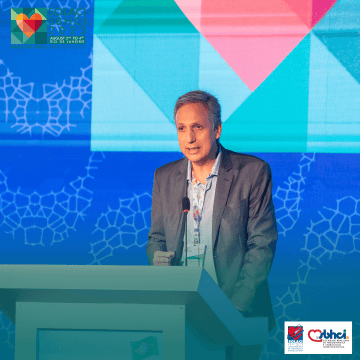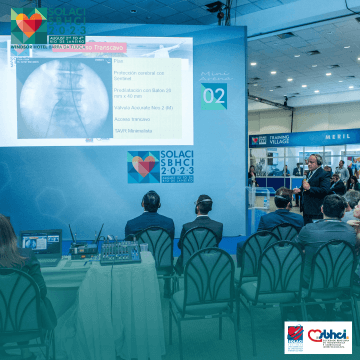Today, the SOLACI SBHCI 2023 Congress, the largest interventional cardiology event in Latin America, organized by the Latin American Society of Interventional Cardiology (SOLACI) and the Brazilian Society of Hemodynamics and Interventional Cardiology (SBHCI), began in Rio de Janeiro.

The event is taking place between August 2nd August 4th at the Windsor Convention Center & Hotels in Barra da Tijuca and it features 8 thematic rooms and 2 interactive spaces, with live cases, edited cases, joint sessions, symposia, workshops, and practical training areas. According to the SOLACI SBHCI 2023 Congress Chairperson, Dr. Hélio Roque Figueira, the event boasts a comprehensive scientific program with significant participation from renowned interventional cardiology experts from Latin America and distinguished international guests.
The program will be conducted in eight thematic rooms: Copacabana, Ipanema, Leblon, Arpoador, São Conrado, Leme, Urca, and Barra da Tijuca. These rooms will host live cases, state-of-the-art sessions, joint sessions with TCT/CRF, SBC, EuroPCR, and SCAI; coronary interventions, edited cases, structural interventions, congenital interventions, extracardiac interventions, simulator training, nursing programming, the MINT/MIL symposium, and the Proeducar-SOLACI Fellows Course.
The following are the main sessions that took place today and will continue throughout the upcoming days:
- ProEducar SOLACI Fellows Course
- MIL/MINT Symposium, emphasizing female leadership in medicine and interventional cardiology
- Honoring Session, a special tribute to past SOLACI presidents and all interventional cardiologists who contributed to the specialty’s growth
- SOLACI RESEARCH, a session dedicated to the primary registries and guidelines of Latin America


Throughout the event, significant joint sessions of SOLACI/SBHCI with TCT/CRF, SBC, EuroPCR, ICI, and SCAI will also take place.
In the Copacabana room, live demonstrations of coronary and mitral interventions were performed directly from Minneapolis, USA, with Dr. Paul Sorajja and Dr. Yader Sandoval, aided by images from Dr. Joao Cavalcante. Additionally, live cases of TAVI and tricuspid interventions were conducted directly from Rio de Janeiro. The room also hosted a joint TCT/CRF and SOLACI/SBHCI session on the state-of-the-art antithrombotic therapy, with the participation of international experts like Dr. Roxana Mehran (USA) and Dr. Marco Valgimigli (ITA).
In the Ipanema room, the day started with a session to discuss the complexity of coronary ischemic disease, featuring Dr. Daniel Chamié (USA) and Dr. Roxana Mehran (USA). Edited cases of chronic occlusions (CTO) performed in Itaperuna, Rio de Janeiro, were presented, along with sessions on coronary atherosclerosis, updates on acute coronary syndromes, and controversies in the cath lab.
In the Leblon room, the day was dedicated to discussions on TAVI, with edited cases from Argentina and Brazil, as well as sessions on TAVI indications, controversies, complication prevention, and various scenarios of transcatheter aortic valve implantation.
The Arpoador room was chosen for discussions on congenital heart disease, with the presence of one of the world’s leading icons in congenital intervention: Dr. Lee Benson. It was followed by a colloquium with important national and Latin American figures on technological advancements in current congenital cardiology and future proposals. Subsequently, a treatment table for newborns addressed topics such as ductal occlusion in low-weight newborns, stents in the ductus arteriosus, and right ventricular outflow tract interventions for patients dependent on the duct for pulmonary circulation.
In the afternoon, two edited cases of percutaneous treatment for ASD and PFO were presented, followed by lectures and discussions on percutaneous closure of complex VSDs and ASDs. The day was brilliantly concluded by the Canadian master, Lee Benson.
The São Conrado room hosted discussions on percutaneous treatment of acute and chronic pulmonary thromboembolism, iliac artery lesions, and their management, as well as interventions in the aorta. It also featured a satellite symposium on optimizing CTO treatment, with the presence of Dr. Joao Brum de Oliveira.

In the URCA room, on the first day of the congress, the ProEducar-SOLACI 2023 Fellows Course was conducted, which has been held continuously since 2010. The course is focused on practical approaches based on the knowledge and skills of recognized interventional cardiology experts, in an intensive and interactive manner, enabling the audience to learn new concepts and updates across the broad spectrum of interventional cardiology. Since 2019, the course has been part of the congress’s scientific agenda, taking place on the first day of the event. With an annual average of 100 participants, attendees can optionally take an evaluation at the end of the course, with interesting prizes for the highest scores. This year, the top performers were awarded a scholarship for the SCAI Fall Fellows Course, which will take place from December 2nd to December 6th this year in Miami, Florida.
The event also featured a specific room for discussions and simulator use to teach the public about TAVI, transseptal puncture, and bifurcation lesions, all concentrated in the Leme room.
Barra da Tijuca was chosen as the venue for discussions by the nursing team working day-to-day in the hemodynamics lab. Additionally, it hosted a symposium on structural interventions and a live case directly from Argentina.
At the end of the day, a solemn ceremony was held in the Copacabana room with the presence of Dr. Ricardo Alves da Costa, President of SBHCI, and Dr. Aníbal Damonte, President of SOLACI, for the official opening of the event. The event was also attended by political authorities from Brazil, such as the Honorable Mayor of Rio de Janeiro, Mr. Eduardo Paes, and the Honorable Secretary of Health of the State of Rio de Janeiro, Dr. Luiz Antônio Teixeira Junior.
Stay tuned for daily newsletters and coverage of this congress, which is the largest interventional cardiology event in Latin America.
Subscribe to our weekly newsletter
Get the latest scientific articles on interventional cardiology





